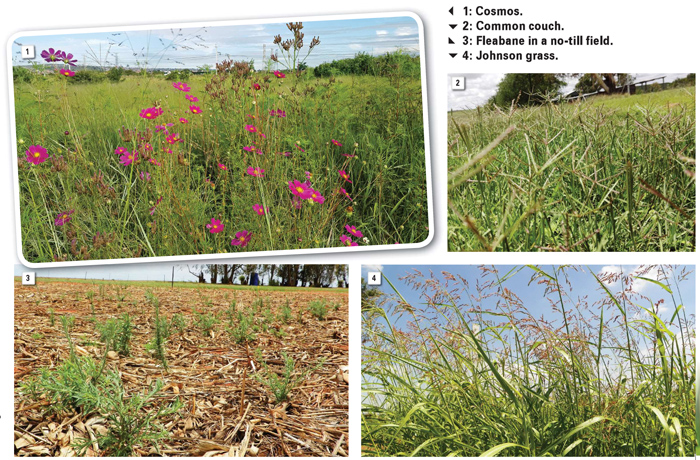September 2018
The slow growth rate of sorghum and the sensitivity of this crop to most herbicides, present the greatest challenges associated with effective weed control in sorghum. Despite these challenges, an effective weed management strategy in sorghum is similar to the weed management strategies of any crop and is based on a few fundamental principles.
Correct identification of problem weeds
Pigweed (misbredies), thorn apple (oliebome), khaki weed (kakiebos), nutsedge (uintjies), morning glory (purperwinde) and cocklebur (kankerroos) are common weeds found in sorghum fields in South Africa. In the sorghum production areas of the Highveld area, cosmos (Photo 1), common couch (gewone kweek, Photo 2) as well as fleabane (vaalskraalhanse, Photo 3), have also been reported to be problematic – especially under minimum tillage practices. Johnson grass (Photo 4) remains one of the most challenging grass species that has to be managed in sorghum production.
As no single herbicide will be able to control all of the weeds in a field effectively, it is imperative to accurately identify the whole weed spectrum in order to select suitable herbicides. In specific cases it might be necessary to use mixtures of compatible herbicides to be able to control the whole weed spectrum. Should control with herbicides not be effective, alternative options must be explored.

Chemical control
Pre-emergence herbicides
Grass weeds can be extremely difficult to control post-emergence in sorghum production due to the lack of selective herbicides. Therefore, sorghum producers rely heavily on the use of registered, pre-emergence herbicides (acetochlor, alachlor, metolachlor, dimethenamid-P or s-metolachlor).
It is imperative to pre-treat sorghum seed with a safener (fluxofenim; Concep®) to protect the seed against the pre-emergence application of s-metolachlor (as per the Concep label). All pre-emergence herbicide labels should, however, be consulted in this regard as acetochlor, alachlor, metolachlor and dimethenamid herbicide labels indicate that the treatment of seed with a registered safener such as Concep will provide protection against crop injury.
Without the use of seed protectants, crop injury such as poor emergence, whiplashing of leaves and stunting can occur.
Atrazine based herbicides (for the control of broadleaves) are also available as pre-emergence herbicides (alone or in combination with e.g. s-metolachlor). If such a herbicide is used, careful note must be taken of the residual effect caused by the active ingredient. Atrazine containing herbicides often have quite extensive waiting periods before a follow-up crop such as sunflower can be planted.
The application dosage of a pre-emergence herbicide is dependent on the soil clay percentage. Soils with a higher clay content warrants a higher herbicide dosage. In the case of pre-emergence herbicides, between 10 mm to 20 mm rain or irrigation is required within four days after application for the herbicide to be washed into the soil.
Post-emergence herbicides
In sorghum fields, broadleaf weeds can be effectively controlled through the application of post-emergence herbicides. To achieve optimal control, herbicide labels should be consulted to determine the growth stage of the weed recommended at application.
Typically, weeds between the two and four-leaf stage are most effectively controlled. Herbicides applied beyond the four-leaf stage of the weed will result in poor to no control. Irrespective of the crop, pre-emergence control remains the most effective manner of weed control, because it eliminates early competition of the weed with the crop and is critical for optimal crop yield.
When applying post-emergence herbicides, label instructions regarding the dose required must be followed to the letter. The objective must be to control the weed without harming the crop. The capability of the crop to come through such an application unscathed depends on its capability to metabolise or detoxify the herbicide.
If the dosage applied is too high, the ability of the crop to break the active ingredient down will be compromised and crop injury may occur. A dosage rate that is too low will result in poor weed control and can aid the weed in resistance build-up.
In the case of post-emergence herbicides, a certain rain free period (up to eight hours in some cases) is required in order for it to be rain fast. If it rains within this prescribed rain free period the herbicide will be washed off and not be taken up by the weeds. Furthermore, weeds that are under drought or heat stress will take up less herbicide, which will result in reduced efficacy of the herbicide. Producers are therefore urged not to apply herbicides during these unfavourable conditions.
Adjuvants aids or modifies the active ingredient in a herbicide so that the herbicide can function optimally. Some herbicides already contain these adjuvants in its product mixture whilst others require the adding of an adjuvant. However, not all adjuvants are the same and only those listed on the relevant herbicide label can be added. The application of an adjuvant not listed on the label could result in excessive dispersal of the herbicide, which dilutes the active ingredient applied and/or shorten the evaporation period.
Cultivation practices and crop rotation
The control of common couch, fleabane and Johnson grass present in a sorghum field requires careful planning. Glyphosate as well as paraquat are often utilised in their control, of which neither is registered on sorghum. These weeds are accordingly controlled before planting, or through crop rotation with other crops on which these herbicides are registered. In the case of Johnson grass, two to three years of crop rotation are required, before sorghum can be planted again.
 Producers are welcome to contact the weed science section of ARC-Grain Crops at 018 299 6100 with any enquiries they might have.
Producers are welcome to contact the weed science section of ARC-Grain Crops at 018 299 6100 with any enquiries they might have.
Publication: September 2018
Section: Focus on integrated pest control